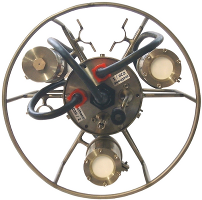
METS - an underwater methane sensor
Function principle
A methane sensitive detector is located in a detector room in the sensor head. The detector room is protected against water and pressure by a silicone membrane. The gas molecules diffuse through the membrane, following the partial pressure gradient between water and detector room, according to the Law of Henry. Hence, the concentration in the detector room is directly correlated to the concentration in the outside water. The correlation is expressed by the calibration formula.
| Response time: | reaction time within few seconds T90 between 1 and 30 min depending on version and deployment conditions |
 |
|
Size: diameter 49 mm; length over all approx. 200 mm No internal moving parts or pumps, hence lower failure risk and lower power drain. |
| Material (housing and connector) | Titanium | |
| Weight in air METS (classic, IR, W) | 0.8 kg | |
| Weight in air K-METS | 1.4 kg | |
| Connector (manufacturer: Subconn) | MCBH8M-Ti | |
| Depth | 4000m |
Application example
 |
Detection of methane hydrates at the sea-floor Adaptation of METS sensors to a CTD logging system View on the bottom |
Further applications
Oil industry: offshore oil and gas exploration, survey and inspection, pipeline leak detection
Sewage treatment plants: basin aeration control
Waste water ducts: control of methane presenc